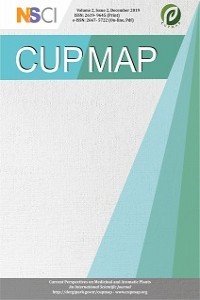Ethnobotanical Survey of Some Plants Used in Tessala Region, Algeria
Ethnobotanical Survey of Some Plants Used in Tessala Region, Algeria
Aromatic plants, Ethnobotanical study, Flora, Inventory Medicinal plants, Traditional, Valorization,
___
- 1. Adrar.J ; 2015 Plantes aromatiques et médicinales du Haut Atlas Oriental l’Université d’Errachidia Morocco p4- 61
- 2. Baba Aissa F 2011, Encyclopédie des plantes utiles. Edition Elmaarifa, 73-269
- 3. Bachir Bouiadjra. S, El Zerey. W and Khéloufi Benabdeli, 2012 Étude diachronique des changements du couvert végétal dans un écosystème montagneux par télédétection spatiale : cas des monts du Tessala (Algérie occidentale) », Physio-Géo, Volume 5 | -1, 211-225.
- 4. Baroudi.M, Benabdeli. K ; 2011 Incidence de la fluctuation des précipitations sur l'occupation des sols dans les hautes plaines de Sidi-Bel-Abbès (Algérie) Physeo-géo volume 5./10.4000
- 5. Belkhadar, J ; 1997 La pharmacopée marocaine traditionnelle, médecine arabe ancienne et savoirs populaires Editions le Fennec. Casablanca. 129-533.
- 6. Bellakhdar.J ; 2013 Hommes et plantes au Maghreb element pour une méthode en ethnobotanique edition le Fennec.Paris.
- 7. Dellile L ; 2010 Les plantes médicinales d’Algérie. Édition Berti, 200 p ISBN/EAN : 9789961692028.
- 8. Dif, M., Benali-Toumi, F., Benyahia, M. et al. 2015 Enquête sur l’utilisation phytothérapique de 11 plantes médicinales poussant dans le Tessala. Phytothérapie 13, 295–297. https://doi.org/10.1007/s10298-015 0962-y
- 9. Djermouni.N; 2003.100 plantes médicinales d’Algérie. OPU Office des Publications Universitaires, Alger.P100, ISBN: 978.9961.0.0304.6.
- 10. Guedira . K, Goetz. P ;2008. les plantes médicinales second Edition Readers Digest Paris p10. ISBN13 987-7098-2020-9
- 11. Khitri. W, Lardjam.A ; 2018 Plantes antilithiasiques utilisées en médecine traditionnelle dans la ville d’Oran, Algérie Approche ethnobotanique et phytochimique éthnoécologie, 10.4000/ethnoecologie.2511.
- 12. P. Quezel, S. Santa, 1962, Nouvelle Flore d’Algérie et des régions désertiques méridionales TOME I et II CNRS, Paris France 1170p
- 13. Paul Ozenda, 1991, Flore et vegetation du Sahra, 3e édition CNRS. 680P ISBN : 2271062306.
- 14. Rebbas. K 2012 ; Plantes d’intérêt médicinal et écologique dans la région d’Ouanougha (M’Sila, Algérie) Phytothérapie 10:131–142
- 15. Saad. B, Said.O; 2011 Greco-arab and Islamic Herbal Medicine Traditional system, ethics,Safety efficacy and regulatory issues Wiley edition.
- 16. Tahri, N., El Basti, A., Zidane, L., Rochdi, A., & Douira, A. (2012). Etude Ethnobotanique Des Plantes Medicinales Dans La Province De Settat (Maroc). Kastamonu Üniversitesi Orman Fakültesi Dergisi, 12(2), 192-208.
- ISSN: 2619-9645
- Yayın Aralığı: Yılda 2 Sayı
- Başlangıç: 2018
- Yayıncı: Nazım ŞEKEROĞLU
Ethnobotanical Survey of Some Plants Used in Tessala Region, Algeria
Bellifa NAZIM, Toumi HOUARI, Benhaddou ISMAIL
Holem H.BALAKY, Eyyüp KARAOĞUL, Ertuğrul ALTUNTAŞ, Alaa Taha Younis HAMMADI, Ali Mala Khedir GALALAEY, Mehmet Hakkı ALMA
Economically Important Sage Species from Turkey: Salvia fruticosa Mill. and S. aramiensis Rech fil.
Abolfazl JAFARI-SALES, Mehrdad PASHAZADEH
Kusum SAI, Hari Prasad DEVKOTA, Rashmi THAPA, Prakash POUDEL, Khem Raj JOSHI
The Efficiency of BIOAPIFIT® Wound Care Ointment in the Treatment of Venous Ulcers
Višnja OREŠČANIN, Zrinka MIHALIĆ, Josipa RODIĆ, štefica FINDRI GUŠTEK
A Study on Antioxidant and Antimicrobial Activity of Ferulago galbanifera Species
